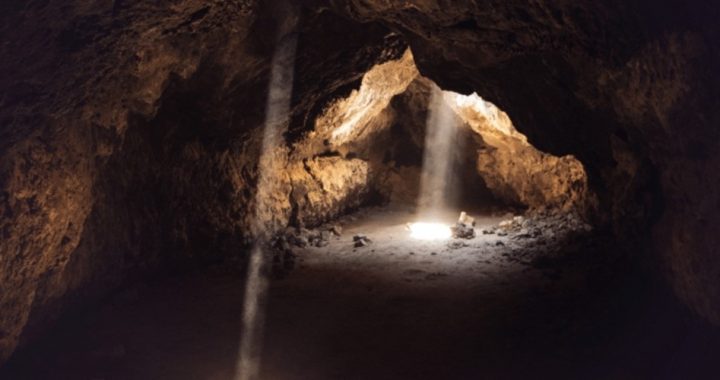
Readers of the Old Testament are familiar with the Ark of the Covenant, the sacred golden chest carried by the Israelites during their wanderings in the desert and finally placed in the temple built by King Solomon. The 1981 adventure/fantasy film Raiders of the Lost Ark by Steven Spielberg and George Lucas introduced a Hollywood version of the Ark to a much larger global audience outside the Jewish and Christian traditions. That movie ends with the Ark disappearing in a large crate, along with thousands of other similar crates, into a huge U.S. government warehouse.
The Ark did indeed disappear, but not following World War II, as Hollywood portrayed, and not into a top-secret warehouse. There is much dispute among scholars and researchers about when, and by whom, it was removed from the Temple. Some believe it was taken to Babylon, following the Jewish-Babylonian War, which culminated in 586 B.C. with Babylonian King Nebuchadnezzar II plundering and destroying Jerusalem, slaying most of the Israelites, and taking most of the survivors into captivity. Others hold that the Ark is in Aksum, Ethiopia, or that it is buried in a tunnel under the Temple, or that it is in a cave beneath Golgotha (also known as Calvary), the hill on which Jesus Christ was crucified. At any rate, it has been “missing” for well over two millennia, its location known only to God.
Jim Barfield believes it is in Qumran, the area of the Judean Desert where the Dead Sea Scrolls were found. In 1952, a fragile scroll made of copper was discovered in a cave above the Dead Sea at Qumran. The Copper Scroll is materially unique in that it was written on thin, hammered copper, rather than the less-durable papyrus or parchment, which were the materials used for all of the other scrolls. Jim Barfield, founder and director of The Copper Scroll Project, believes he has found in the enigmatic Copper Scroll the key to the location of the cave where the Ark of the Covenant is hidden, along with the Tabernacle in the Wilderness and the Altar of Incense. The Copper Scroll, he believes, also shows the locations of 56 additional sites where vast hoards of sacred treasures are buried — including tons of Temple items made of gold and silver from the Temple of Solomon.
{mp4}tna-2018-bill-jasper-jim-barfield-copper-scrolls-project-hd{/mp4}
The clues provided in the Copper Scroll, Barfield says, are reinforced by the ancient account of the prophet Jeremiah (Jeremias) in the Second Book of Maccabees, which recounts that Jeremiah removed the Temple treasures from Jerusalem before the city fell to Nebuchadnezzar. The account in II Maccabees reads:
You shall also find it set down in the dispositions made by the prophet Jeremias, that he bade the exiles rescue the sacred fire, in the manner aforesaid. Strict charge he gave them, the Lord’s commandments they should keep ever in mind, nor let false gods, all gold and silver and fine array, steal away their hearts; with much else to confirm them in their regard for the law. And here, in this same document, the story was told, how a divine oracle came to Jeremias, and he must needs go out, with tabernacle and ark to bear him company, to the very mountain Moses climbed long ago, when he had sight of God’s domain. A cave Jeremias found there, in which he set down tabernacle and ark and incense-altar, and stopped up the entrance behind him. There were some that followed; no time they lost in coming up to mark the spot, but find it they could not. He, when they told him of it, rebuked their eagerness; Nay, said he, the place must remain ever unknown, till the day when God brings his people together once more, and is reconciled; then, divinely, the secret shall be made manifest. Then once again the Lord’s majesty shall be seen, and the cloud that enshrines it; the same vision that was granted to Moses, and to Solomon when he prayed that the great God would have his temple on earth; Solomon, the master of wisdom, that in his wisdom offered sacrifice to hallow the temple he had made.
Utilizing the copper scroll, the Book of Maccabees, and other ancient sources, Barfield has created a map of Qumran depicting where he believes the 57 Temple treasure sites are. In 2009, he was able to put his theories from the copper scroll to the test. With the help of a member of the Israeli Knesset, he and his team were allowed to conduct a survey of four of the sites utilizing advanced scanning detector technology that allowed them to see 50 feet below the surface of the ground. According to Barfield, their detector showed “massive amounts” of nonferrous metal objects in precisely those locations. This, he says, is an exciting confirmation to him that they are on the right track. He is confident that the objects depicted by the detector are indeed the much-sought-after Temple treasures. Most exciting of all, he says, were the detector readings for the cave location where he believes the greatest treasures, including the Ark of the Covenant, are hidden. That’s where the detector gave off the biggest readings for nonferrous metals, indicating to him they had found the Ark and the other most important gold and silver Temple objects.
Jim Barfield has been to Israel 15 times in the past 11 years in efforts to advance the Copper Scroll Project’s mission, which he says is to “Help the Nation of Israel recover the items of the Copper Scroll.”
Barfield was not surprised that his initial approaches to Israeli authorities and archeologists were met with skepticism. Besides being an outsider, without the archeological credentials and experience of other noted authorities in this field, there are tremendous political sensitivities and rivalries involved that complicate any excavation effort. “The political and religious ramifications of this are huge,” he told The New American in a recent telephone interview. “The Palestinians certainly don’t want anything like this that would confirm Israel’s historical claim” to the area.
In addition to the Palestinians, there are also influential Israelis who are opposed to the project. Some are opposed to it because they fear a discovery of this sort would lead to increased Arab-Israeli tensions and an increase of attacks by the Palestinians against Israelis. Other Jews, says Barfield, particularly the wealthier, non-religious classes, see it as a threat because they fear it would lead to greater religious fervor among the Jews and a clamor to build a third temple, which they oppose.
Our video interview with Barfield embedded above was conducted in 2016. However, because of political instability in Israel at the time and security concerns, he asked us not to post it at that time. Since then, he says, the Copper Scroll Project has made enormous strides. “On our last visit to Israel — in September last year — we had a very good meeting with a top Israeli archeologist and a high official in the Israeli government,” he told The New American. The official from the Israeli government, when presented with all of Barfield’s evidence, became very interested and supportive.
Jim Barfield has worked on the Copper Scroll Project for more than a decade. He has experienced many delays, setbacks, and roadblocks, as well as more than his fair share of detractors. He freely admits to getting impatient and discouraged at times. However, he firmly believes that, ultimately, God is in control of world events, and he intends to remain faithful to what he believes is God’s calling for him in this historic effort. The Ark of the Covenant will be revealed “in God’s good time,” he says. “It might not be Jim Barfield whom He uses to reveal it, but that’s not what’s important — I’m not important. What’s important is that I faithfully carry out His will for me, as I understand it.”
We, at The New American, take no position on the validity or accuracy of the findings and claims of Jim Barfield and the Copper Scroll Project. Whether or not he has truly discovered the Ark of the Covenant will likely only be revealed by time — and a shovel. However, we were intrigued enough with the subject to do this interview and report. We believe our readers may find it intriguing, if not fascinating, especially in light of the recent developments concerning President Trump’s focus on Jerusalem.
Photo: courtesy of The Copper Scroll Project



